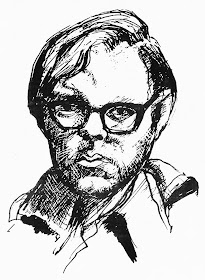Keith Roberts was a remarkable writer who never found the audience that he deserved. Unlike his contemporaries J. G. Ballard and Brian Aldiss whose novels are now acceptable to critics as fiction rather than ghettoised as science fiction or fantasy, Roberts talents were only recognised within the genre. Algis Budrys considered him the best short story writer in Britain, he won four British SF Association Awards in three categories (novel, short story and artist) and his alternate history novel Pavane was praised by Anthony Burgess as one of the best novels of the twentieth century.
What held Roberts back was almost certainly Roberts himself. He was not especially prolific, writing some 120 stories (a third of them in the period 1964-67) which were gathered into nine collections; four of his nine novels were actually mosaics of interlinked novellas. Nor was he easy to categorise. His first novel, The Furies, was a failed attempt to produce a catastrophe novel in the vein of John Wyndham or John Christopher. His next, Pavane, was a virtuoso alternate history novel in which Queen Elizabeth was assassinated in 1588 and the reformation and industrial revolution never take place; by 1968, the Catholic Church has held power for 400 years, suppressing all technological development as heresy. This was Roberts’ first mosaic novel, each part of the story told from a different viewpoint but building a picture of a world that was extraordinarily different to our own. Much of it is set in a beautiful Southern England, where hauliers ply the roads in steam-driven locomotives and giant semaphore stations dominate the countryside. Roberts wrote evocatively of these strange times when a challenge to the rigidness of the Church begins to grow, waiting the spark of an invention to begin the process of revolution.
Roberts’ later novels were no less challenging: The Inner Wheel dealt with gestalt minds and an encroaching world war, The Boat of Fate was a historical of Roman Britain, and The Chalk Giants saw struggling loser Stanley Potts try to escape visions of post-nuclear cataclysm which all in some form feature Martine, the girl he loves. Girls played a large part in Roberts stories, from his earliest humorous tales about a young witch named Anita to the adventures of Kaeti, whose slightly skewed England is also the home of vampires, ghosts and other odd denizens. In Molly Zero, his heroine Molly rebels against the bureaucratically complex future England, and in Gráinne, the narrator, writer and adman Alistair Bevan (a pen-name used by Roberts on some of his early stories), finds his fate entwined with that of the girl-goddess of the title.
Roberts himself seemed unable to form steady relationships, professionally or personally. Unmarried and living alone in a rented flat, for years he refused to deal with major publishers, accusing them of creative accounting over the royalties of his early books. Even when he dealt with small press publishers the relationship would often sour, not helped by Roberts’ sudden mood swings and self-destructive tendencies. He could be withdrawn and uncommunicative, yet on other occasions would be a good companion. He remained close-lipped about his private life and even the autobiographical Lemady is an idiosyncratic mixture of fact and fantasy as Roberts draws sketches from his life, focusing largely on his arguments with publishers, and interacts with the fictional woman of the title.
Keith John Kingston Roberts was born in Kettering, Northamptonshire, on 20 September 1935, and studied for his National Diploma in design at Northampton School of Art, later attending Leicester College of Art. He worked in advertising and illustration before selling his first story. Roberts was closely associated with the magazines Science Fantasy and New Worlds, drawing covers and contributing stories to both. When Science Fantasy changed its name to Impulse, Roberts became associate editor and then managing editor. As an illustrator he later produced covers for books by Philip K. Dick and John Brunner, two other science fiction writers who struggled to find their proper place in literature.
A new short novel, Drek Yarman was serialised in the UK magazine Spectrum SF earlier this year and Roberts had recently signed a deal with Wildside Press which would have brought much of his work back into print, perhaps to wider recognition. Unfortunately, only three titles had appeared by the time he died on 5 October 2000, aged 65, of complications arising after he had been hospitalised for a chest infection.
(* Originally written for The Guardian where it appeared on 16 October 2000. This is the submitted version, which is slightly different to the published version. The column header illustration is a self-portrait by Keith Roberts for Paul Kincaid's British Science Fiction Writers, BSFA, 1983.)
skip to main |
skip to sidebar

About Me

- Steve
- Freelance author and editor for the past 30 years. My interests are old British comics, books and magazines... and that's what you'll find here.


No comments:
Post a Comment